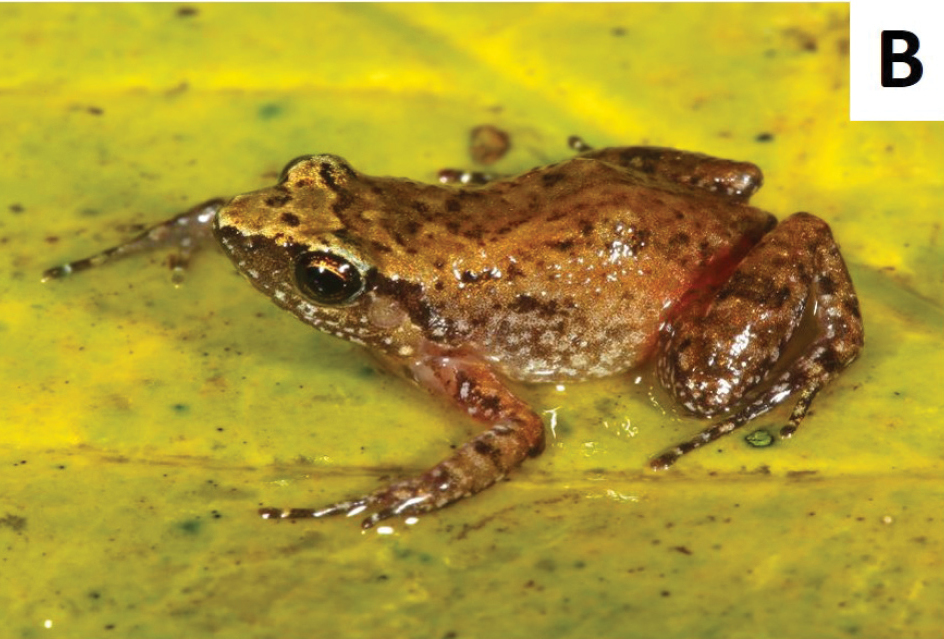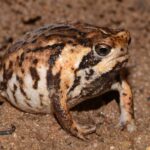- Introduction: A Tiny Voyager of Forest Floors
- Taxonomy and Classification
- Natural Habitat: East Africa's Hidden Gem
- Physical Characteristics: Small but Mighty Adaptations
- Behavior and Life Cycle: Quietly Thriving in the Shadows
- Ecological Role: Guardians of Balance
- Threats and Conservation Status: Safeguarding a Fragile Resident
- Cultural and Scientific Significance: More Than Meets the Eye
- Conclusion: Celebrating and Conserving the Invisible
Introduction: A Tiny Voyager of Forest Floors#
Beneath a dense canopy of lush, emerald foliage in East Africa’s vibrant montane forests, a small creature moves silently through fallen leaves and lush understory. Hardly bigger than a thumbnail, yet indispensable to its ecosystem, this is Arthroleptis xenodactyloides, a remarkable and seldom-seen frog species whose discreet existence belies a rich ecological story. Also known by its common name, the Dwarf Squeaker, Arthroleptis xenodactyloides is proof that nature’s most intriguing stories often unfold in miniature.
Within the intricate web of life, the survival of many larger, more charismatic animals depends critically on the quiet workings of these unnoticed amphibians. Small in stature yet big in biological significance, Arthroleptis xenodactyloides exemplifies the profound interconnectedness inherent in natural ecosystems.
Taxonomy and Classification#
Arthroleptis xenodactyloides belongs to the diverse amphibian family Arthroleptidae, a widespread group encompassing terrestrial frogs generally adapted for life away from water bodies. The genus Arthroleptis, known collectively as “squeakers” due to their characteristically high-pitched calls, includes approximately 50 unique species across sub-Saharan Africa.
First described scientifically in 1933 by British herpetologist Hampton Wildman Parker, the species epithet “xenodactyloides” hints at the structure and length of its strangely slender toes—a distinct feature that allows accurate identification among closely related species. While taxonomic debates occasionally surface regarding cryptic sister species within the genus, Arthroleptis xenodactyloides remains clearly defined, granting clarity to ecological research and conservation planning.
Natural Habitat: East Africa’s Hidden Gem#
The geographic distribution of Arthroleptis xenodactyloides spans several Eastern African countries, notably Tanzania, Malawi, Mozambique, Kenya, Zimbabwe, and even parts of Zambia and the Democratic Republic of the Congo. Here, the species thrives in humid montane forests and submontane regions situated between approximately 800 and 2,400 meters above sea level.
Picture moist, shaded secondary forests, the air scented by rich, damp soil and rotting leaves—a thick, protective carpet hosting a remarkable microcosm of diversity. In this environment, Arthroleptis xenodactyloides thrives amidst leafy litter, secretive in movements and perfectly camouflaged against a tapestry of earthy browns and deep greens, expertly avoiding predation with stealth and patience.
This frog’s successful adaptation to leaf-litter habitats underlines their critical dependency on healthy, undisturbed forest ecosystems. It also highlights the importance of preserving these habitats to protect myriad hidden ecological interactions that keep forests vibrant and healthy.
Physical Characteristics: Small but Mighty Adaptations#
A diminutive and cryptically colored frog, Arthroleptis xenodactyloides rarely exceeds 20 millimeters in length. With hues ranging from sandy brown and earthy tones to dark russet, the frog’s finely etched skin patterns render it nearly invisible amidst leaf litter, providing an adaptive cloak against vigilant predators.
A closer observation reveals subtly elongate fingers and toes, critical for its terrestrial existence—a trait believed to improve stability and mobility across difficult forest terrain. Its eyes, relatively prominent against its small head, provide excellent peripheral vision essential for detecting predators and opportunistic prey.
These adaptive traits not only enhance survival but allow the frog to occupy specific ecological niches not easily exploited by other amphibians, illustrating evolutionary creativity and adaptability even within minute organisms.
Behavior and Life Cycle: Quietly Thriving in the Shadows#
Feeding and Predation Strategies#
As primarily an insectivore, Arthroleptis xenodactyloides searches with utmost stealth for small invertebrates like ants, termites, tiny beetles, and springtails among damp leaf litter. With deliberate, patient movements and quick reflexive strikes, it efficiently harnesses abundant but elusive prey within its specialized niche.
The frog’s diet plays a vital role in maintaining balanced arthropod populations on the forest floor, underscoring its hidden ecological importance.
Reproduction and Life Cycle#
A striking element in the biology of Arthroleptis xenodactyloides is its remarkably independent reproduction cycle. Unlike many amphibian counterparts dependent on standing water for tadpole development, Arthroleptis frogs exhibit direct development—embryos transform fully within gelatinous eggs deposited beneath moist leaf litter, emerging as fully formed miniature versions of adults.
This direct development is a significant evolutionary advantage, allowing them to reproduce successfully within habitats devoid of reliable water sources, demonstrating yet another remarkable adaptation. Their high-pitched call, often compared to a subtle squeak or chirp, serves as a critical mechanism in mating rituals, with males calling from concealed locations to advertise their presence to potential mates.
Ecological Role: Guardians of Balance#
The impact of Arthroleptis xenodactyloides extends far beyond its modest size. As natural pest controllers of floor-level insect populations, these frogs contribute significantly to forest health, ecosystem balance, and biodiversity regulation.
Furthermore, Arthroleptis xenodactyloides serves as prey to a variety of predators—including birds, reptiles, and small mammals—thus occupying a critical intermediary trophic level. Its health and population stability are deeply intertwined with both the health of prey availability and predator populations, serving as indicators of ecological health and environmental stability.
Threats and Conservation Status: Safeguarding a Fragile Resident#
The International Union for Conservation of Nature (IUCN) currently lists Arthroleptis xenodactyloides as a species of “Least Concern,” primarily due to its broad distribution and adaptable nature. Yet, localized populations face imminent threats arising from habitat fragmentation, deforestation, agricultural encroachment, and climate change.
Climate-induced habitat shifts are especially concerning, given their precise ecological-dependent adaptations. Climate fluctuations could alter rainfall patterns and humidity levels, jeopardizing their delicate balance. Additionally, pesticides and pollutants associated with extensive agriculture threaten amphibian populations by disrupting sensitive reproductive cycles and increasing vulnerability to diseases.
Conservation efforts must therefore integrate sustainable agriculture practices with stringent protection of forest habitats, promoting corridors that allow gene flow and ensuring populations remain genetically robust.
Cultural and Scientific Significance: More Than Meets the Eye#
While Arthroleptis xenodactyloides doesn’t play a dominant cultural role compared to larger, more visible amphibian species, it symbolizes the imperative of valuing even the smallest species in conservation narratives. Scientifically, this frog has become increasingly important as a model organism for studying terrestrial adaptations, reproductive ecology, and bio-indicator roles in forest health assessments.
In local African traditions, amphibians frequently symbolize environmental health and changing rainfall patterns. Maintaining healthy Arthroleptis populations thus underscores a broader socio-cultural recognition of ecosystem stability and climate predictability, vital for human livelihoods across its range.
Conclusion: Celebrating and Conserving the Invisible#
Despite their small size and secretive lifestyle, Arthroleptis xenodactyloides frogs are critical components of rich forest ecosystems, underpinning ecological balance and biodiversity conservation. Their survival, tied intricately to forest health, serves as a gentle reminder of the irreplaceable value of protecting all life’s diversity—from the largest charismatic mammals down to the tiniest, least visible amphibians.
Please consider supporting conservation organizations engaged in protecting East Africa’s incredible biodiversity. Further exploration, education, and advocacy will ensure that frogs like Arthroleptis xenodactyloides continue to enrich our planet and our lives, quietly playing their critical roles beneath towering forest canopies and ever-present forest litter, inviting us all to appreciate nature’s subtle grandeur.














